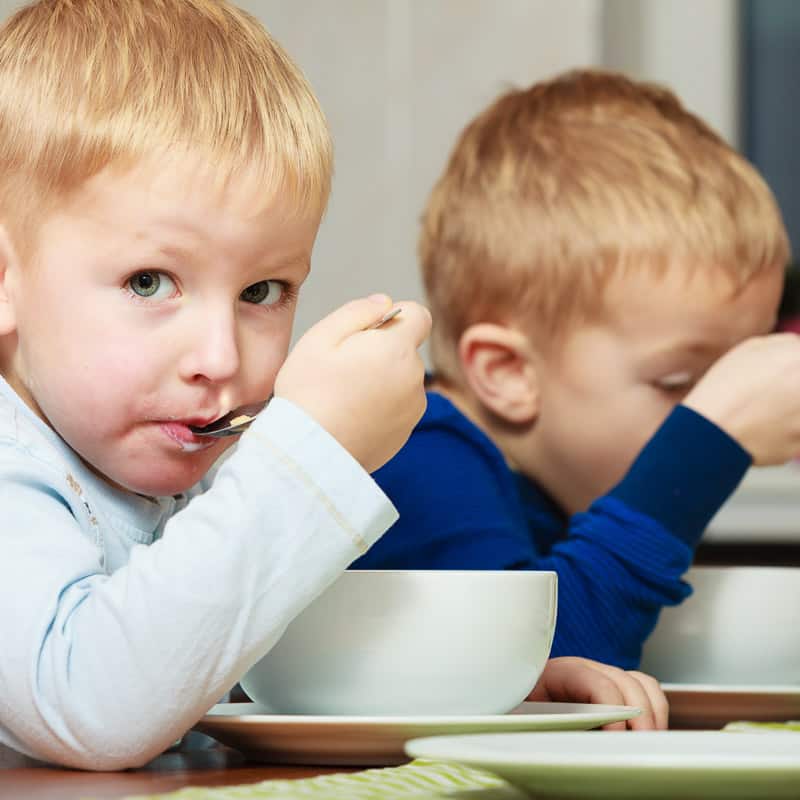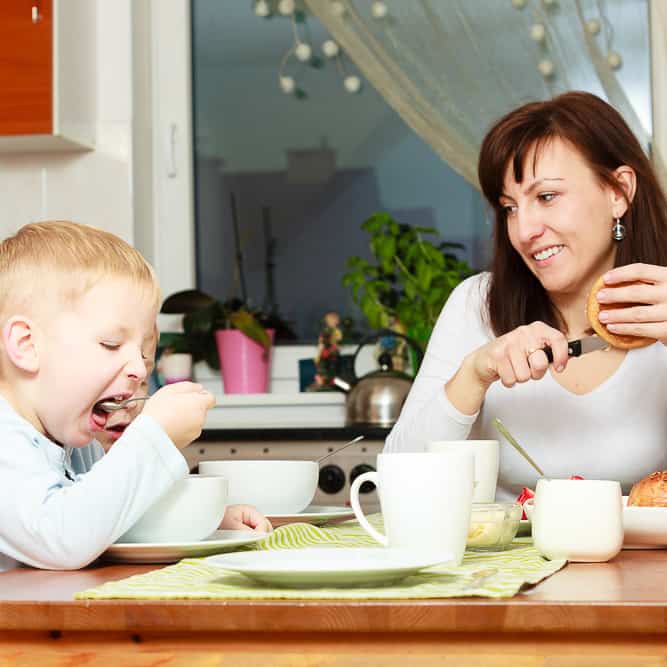9 Tricks to keep your preschooler sitting at the dinner table
Getting preschoolers to stay at sitting at the dinner table can be no mean feat. I'm sure we have all been there with kids getting up and down from the table, under the table, under the chairs, all of a sudden running around the house after what seems like only 2 minutes at the dinner table. I'm going to take you through my 9 tricks to keep your preschooler sitting at the dinner table. But first I wanted to touch on why those extra minutes at the table do matter.

How Long Should Meal Times Be?
This is quite a tricky question as it will depend on your child's age, eating style and your family's schedule. But I must say I found an article on mealtime length written by Jo Cormack Author of War and Peas really interesting. As a qualified therapist focussed on picky eating she suggests that "less than 20 minutes for the main meal is not enough". This is backed up by research quoted in her article. The research shows that more positive effects were associated with meals with an average duration of 19.9 minutes compared to an average of 16.4 minutes. These extra minutes matter! So there we go, the goal is probably a minimum of 20 minutes for the main meal. How do we achieve that?
Tricks to keep your pre-schooler sitting at the table
Preparation is Key
There are a number of things that need to be prepared for a successful and longer meal time with kids.
1. Dinner preparation
The first thing to get prepared is the meal itself. This is 2 fold. Getting your children involved in the dinner preparation will help them to stay sitting at the table. It will help because kids have real pride in the tasks that they have completed. They love to show parents and family members what they have done. Having your child involved in some of the dinner preparation can help them sit at the table for longer. Let them show other members of the family the items they helped prepare, ask them about the steps in the recipe or what parts they completed, those conversations alone will hold their attention at the table for a little while at least.
The second reason for the importance of dinner prep is to keep you at the table. Yes, you the parent. If we want to role model sitting at the table for our kids the easiest way to do this is with our behaviour. Which means we should try to not get up and down from the table too much either. Therefore try to have everything prepped for dinner, everything served and on the table so that there aren't too many times when you have to get up and down. Becuase trust me, as soon as you get up, the kiddos will want to too!
3. Table setting
This leads me quite nicely to tip 2 table setting. Set the table with everything you will need for the dinner meal and get your children involved in the process. Set the table with a complete set of cutlery for everyone (even if the meal doesn't require it) This is because if you have set the table with just forks because a knife isn't necessarily required, trust me your munchkin will all of a sudden NEED a knife. Nip this in the bud, by having everything that could possibly be needed already on the table. This includes a water jug for filling glasses so that they don't need to be refilled from the tap. Again like tip one, this tip is two-fold. Setting the table will also give your child a sense of accomplishment. A feel-good factor right from the start of the meal, and letting them choose place settings etc will mean there shouldn't be any of the "But I wanted the green cup" during the meal time.
3. Prepare the Kids
This actually has a technical term, which is the engagement of the proprioceptive sensory system. Doing this before meals can be a game changer. Simone from play with food covers off the importance in her article Before Dinner Routine for Happy Kids and Happy Parents
In our house it is 2 phase. Phase 1 is to get them moving, get the blood pumping, ie a run outside a bounce on the tramp, followed by phase 2 which is to engage with a quiet activity that they enjoy before the dinner, sit them up at the table for a little colouring while you finish the dinner prep, or you can kill 2 birds with one stone and use tip one and tip two for this, ie get them involved in the final stages of dinner prep and table setting. I write about preparing the kids for dinner in more detail in my earlier article 7 Tips to improve mealtime when you have a picky eater.
4 Bathroom pit stop
The last step preparation step is to make sure kids have had a bathroom pit stop before sitting up at the table. Give them an opportunity to do ones or twos before they all of a sudden need to mmid-meal Note this is not 100% effective. Depsite my best efforts quite often one of my kids needs to have a bathroom stop during a meal, but I think doing our best to prevent it at the start is probably a wise thing.
Save This Recipe!
My first 5 tips fall into the preparation category. Now to look at a few other things
5. One toy
This tip will depend on your parenting phiospphy, but if you have a child who struggles to sit up at the table, one small quiet toy at the table may not be the worst outcome. Their favourite stuffed toy might sit up for the meal as company. Perhaps a piece of paper and 1 or 2 crayons, or a small car. Nothing overbaord but it might help. If you are going to do this, the rule should be that they choose one toy, and it is done during the preparation stage, i.e. once you are up sitting you can't get back down to swap toys etc.
6. A good seat. Don't forget ergonomics.
If you are expecting your child to sit up nicely at the table please make sure they have somewhere comfortable to sit. They need a seat that raises them to the appropriate table height and a seat with a foot rest. It is much easier for children to stay sitting up if they are comfortable, they can reach the table or high chair tray easily and their feet are not swinging about. Swinging feet leads to fidgiting, and sliding, and the next step is your kid is down from the table and running about. For me there are only 3 things you need to consider when purchasing a high chair, and one of the most important is ergonomics. You can find more on this here: how to pick a great highchair.
7. Be realistic with your expectations
In the opening of this article. I mentioned that the optimum length of time for a main meal is most likely 20 minutes or longer. Please be realistic with this. If you have an action packed 2 year old who is tired at the end of the day, their attention span for the main meal will be different to an almost 5 year old. I have 3 children. 2, 3 and 5. At the moment my mealtime goal is 15 minutes. This works well for us. My kids are relatively quick eaters so after 15 minutes I am usually happy they have had enough. As they get older I plan to increase meal time.
You also need to be realistic that you may have to use distraction to keep your kids sitting up at the table. But distraction can be as simple as asking them about their day, starting a conversation, getting them talking or playing a small game with you. Be realistic, toddlers and preschoolers are not going to sit in silence, diligently eating at mealtime, they will need to be engaged.
8. Use a visual cue
Use a visual cue so that the kids know when the compulsory time to sit up for meals is over. You could use the clock for this, ie "The big hand is currently on the 3 we will stay sitting at the table until it gets to the 7. Sand timers are also awesome for this. You can get them for all sorts of durations, choose one that is right for your family and flip it at the start of the meal. I find it is also useful for me, and harks back to the tip of being realistic. Sometimes my kids start fidget and I can feel myself getting on edge, then I realise they've actually done super well and the 15 minute meal time has already passed. i.e the visual timer is sometimes as much for me as it is for them, to keep me realistic!
9. Sit Down and Remain Seated
This tip refers to you, and refers back to tip 1 preparation. I'm emphasising it again as I think it's really important. If you expect your child to sit up for a decent period of time at dinner time, then you need to model this too. Have dinner prep done, everything on the table, put your phone away, and use the visual timer to let you know when it is time for YOU to leave the table. If you want your kids to commit to sitting up at the dinner table for a certain period of time, then you have to as well. If it's not something you can commit to, then you might have to be realistic and understand that asking them to sit up for a decent length of time is not going to work until you can too.
So there we are my 9 tips. They definitely help at our table if I remember to do them all. I'm not perfect and sometimes let things slip. Which is ok. I just have to remind myself that if I haven't made it easy for my kids to stay sitting up by doing the 9 things, then I probably have to be realistic about my expectations for them.




Quick Start Guide To BLW
Baby led weaning doesn’t need to be complicated, grab my quick start guide to begin your little ones food journey.